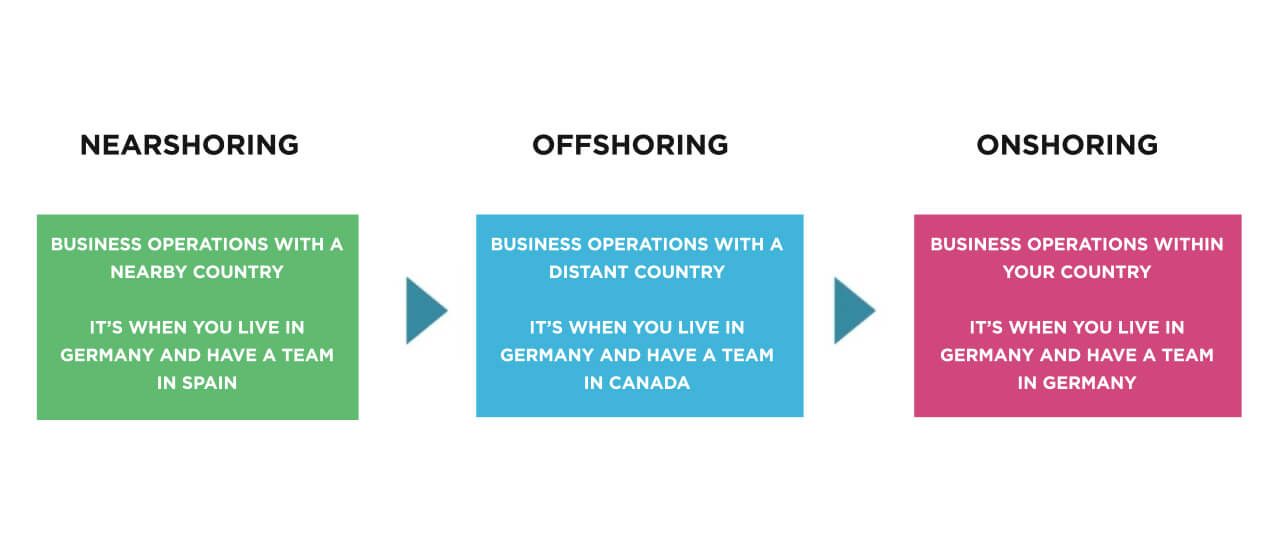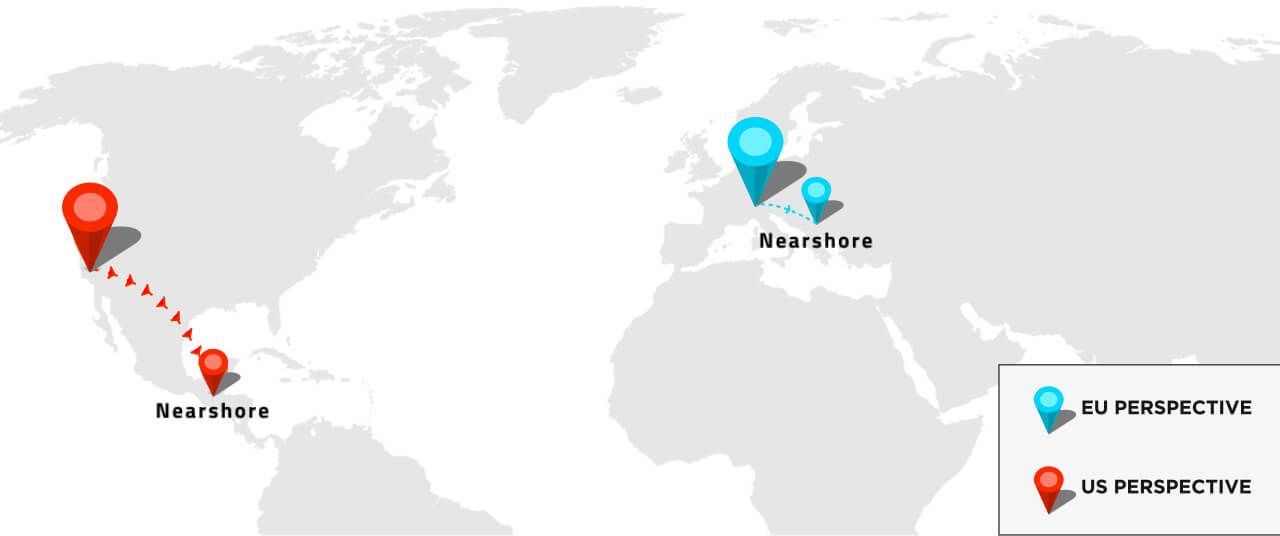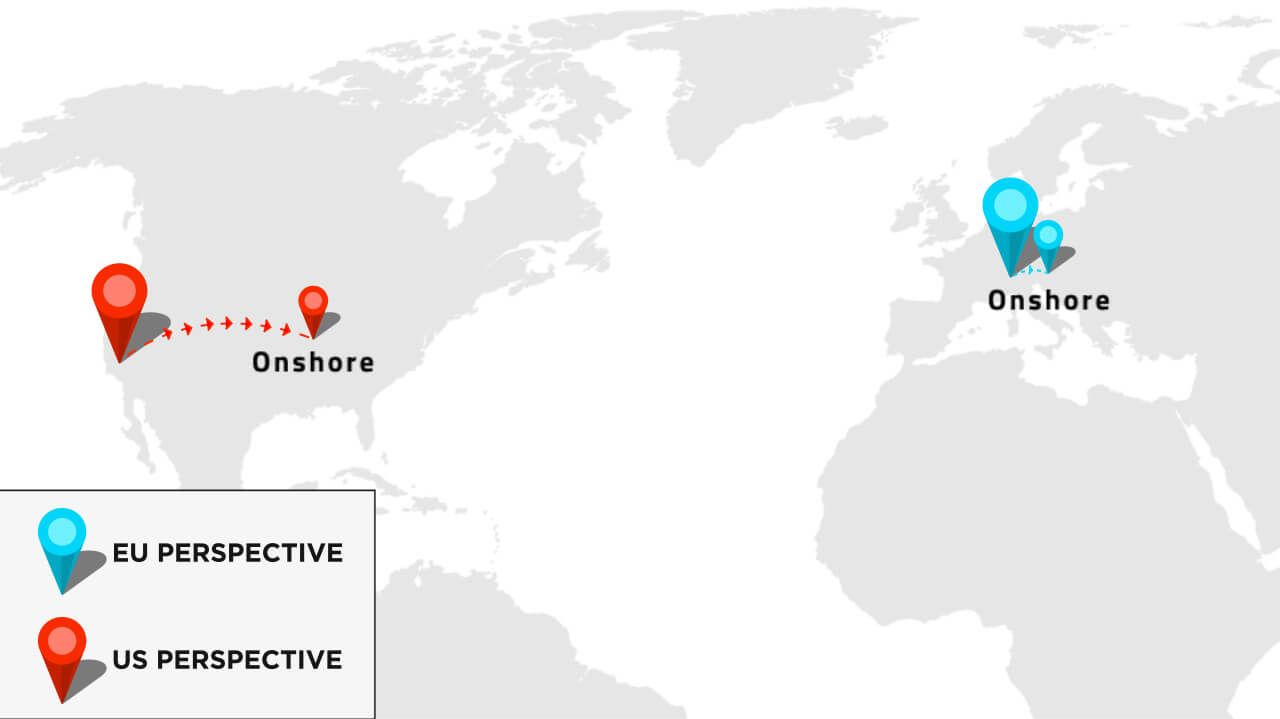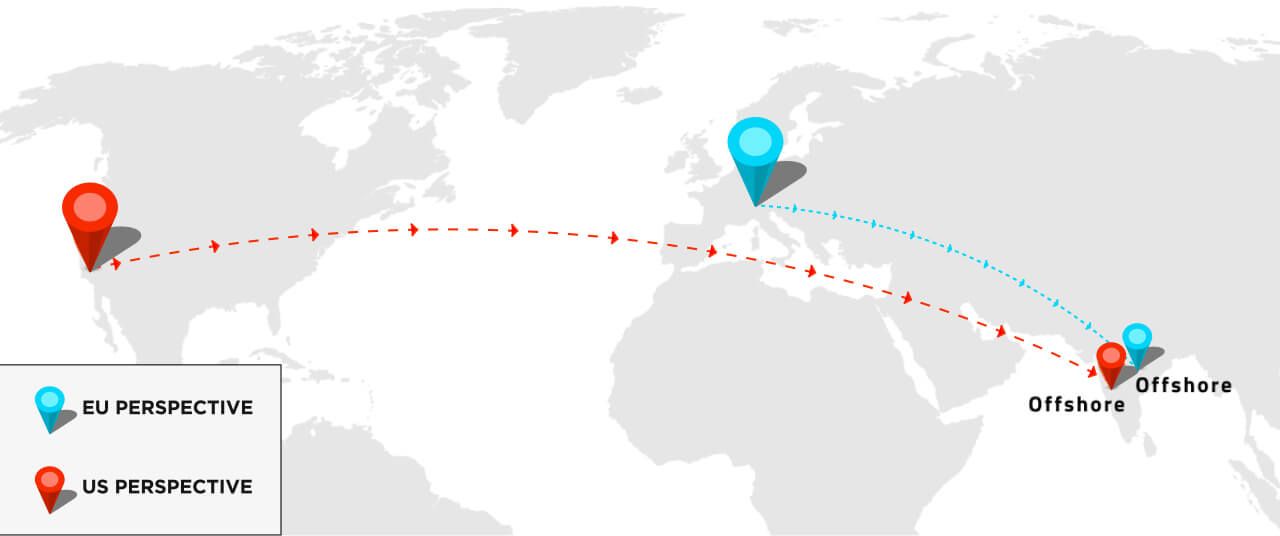Alternatives to Nearshore Software Development Outsourcing

If you are looking to cut costs, scale up your in-house team or focus on revenue-generating work, outsourcing is a viable way to achieve your goals.
According to Statista, IT outsourcing is forecast to account for a revenue of US$351 billion in 2021. Spending in the overall outsourcing industry is the highest within the Americas region.
This is due to a short supply of tech experts to fill all the positions in many leading US-based tech companies—not because there aren’t any good experts in the US, but because there aren’t enough of them.
In case you decide on outsourcing, you’ll need to know more about the different types of outsourcing of software projects. In this article, we will take a look at all the alternatives to nearshore software development outsourcing, pointing out their pros and cons, and what you should consider when deciding on one or another.
Here’s What We’ll Cover
Types of Business Process Outsourcing Based on Vender Location

Service outsourcing can be divided into three main categories according to contractor’s geographical location:
- Onshore refers to hiring vendors located in the same country or even in the same city.
- Nearshore is similar to offshore outsourcing, but the service providers are located in nearby countries.
- Offshore outsourcing implies hiring third-party providers, often situated in other countries in the world.
What Is Nearshoring?
Nearshoring is outsourcing of business processes to a third-party company in a nearby country. For example, let’s say you are a business owner or manager of a firm in Norway. You decided to automate certain processes inside the company or offer online solutions. This project requires in-depth IT knowledge and a team of developers that you don’t have in-house. You find a Lithuania-based company that is suitable for your project. After a few conversations, you decide to collaborate with this company. This is an example of IT nearshoring.

Advantages of Nearshoring
- Nearshoring saves time and energy. You don’t have to form a new department since specialists are provided for you by the company providing nearshore services.
- Nearshoring is cost-efficient. The companies providing nearshore teams are usually based in countries with lower hourly wages. This reduces the costs of your project.
- Working in the same time zone. Working within the same time zone leads to a more stable and productive workforce and increased output. Moreover, travelling between locations is far easier in the nearshore model.
- Ease of communication and understanding. Team interactions are much more comfortable as they happen in real-time. Good knowledge of a common language enables a clear understanding between parties and ensures that the resulting work will satisfy your expectations.
Disadvantages of Nearshoring
- Higher price in comparison with offshore outsourcing. Nearby countries may not be as cheap as other countries farther away. If there are no affordable developers in your region, you are better off hiring an offshore software development company.
- Lack of suitable IT companies. If neighbouring countries are not focused on developing their IT sector, you might not find qualified developers there.
- The need for periodic monitoring. You need to periodically contact your team and monitor the process. Fortunately, holding meetings with nearshore countries is not too complicated. For example, we at VironIT always try to organize video conferences with customers at a time that is convenient for them.
Will Nearshoring Work for Your Business?
If the following statements are true for you, nearshoring might be a good choice for your business:
- You need to establish a new department or boost an existing one.
- You have switched to long-term remote work.
- You want to reduce your business costs.
- You have clear business goals.
- You don’t compromise on quality standards.
- You don’t want to waste time on hiring.
- You want your team available in real-time.
- You support reasonable hourly rates.
However, nearshoring is not the only option. There are two main alternatives to nearshore software development outsourcing: onshoring and offshoring. We will take a closer look at each one below, and consider their advantages and disadvantages.
What Is Onshoring?
In a nutshell, onshoring is outsourcing to another city in your country. In this case, you don’t face the risk of cultural differences or foreign tax policies. However, you often have to accept a higher price range.
Suppose your company is based in New York. In that case, you might consider working with a US-based IT company outside New York State with significantly lower fees.

Advantages of Onshoring
- No communication barriers or cultural peculiarities. With onshoring, you don’t have to worry about communication problems. Workers from the same country and speaking the same language have the best chance of getting along.
- On-site readiness for project emergencies. If necessary, an external team will be able to start working on the project immediately.
- Easier to set up a face-to-face meeting or provide training sessions. Instead of working through an intermediary, you can set up in-person meetings or train the programmers yourself.
- Reduced travel costs. Having workers close to home means that you don’t have to travel far to a third-party company.
Disadvantages of Onshoring
- Limited talent pool. The competition for talent is intense, so there might be a limited pool of skilled programming experts who are available locally in your country.
- Greater costs. Onshoring is more expensive than nearshoring and offshoring. This can be a setback for early-stage startups that need a greater ROI to survive.
Will Onshoring Work for Your Business?
Onshoring may be the right choice for you if the following statements apply:
- Money is not a concern.
- You prefer to work with your fellow citizens.
- You might need or choose on-site deployment.
- You want to avoid communication gaps.
- A good cultural fit is important to you.
What Is Offshoring?
Offshoring means outsourcing business activities to countries that are economically less developed. This is considered the most affordable outsourcing option, which is a significant advantage of this model. However, companies may encounter various issues and challenges. For the US-based company, offshoring destinations could be Asia, Eastern Europe or elsewhere.

Advantages of Offshoring
- Cost-efficient. In this case, the dedicated team of developers will be cheaper than the other two options without making any compromises in the performance or the quality of their work.
- Access to the global talent pool. Offshoring gives you access to the vast talent pool that is available globally. Your teams cut back the risks of labor lags, meagre client engagement, communication, and other challenges.
- Nonstop business operations. Having workers in different time zones provides you with the advantage of nonstop business operations. Adjusted work shifts can ensure that your business is running as you wish at all hours of the day.
- Better customer service. Offshoring isn’t just for cutting costs. It also promotes business and innovation, repositioning your company in the market and allowing you to expand your services and offers.
- Increased focus on the core of your business. Outsourcing some services can give you the necessary time to focus on improving the core of your business.
- Shared risks. Your outsourcing provider would need to assume certain responsibilities for the project, which allows you to share the risk of your investments.
- Flexibility. You have the opportunity to change your staff quickly or to try out different staff members until you find the ones that are most suitable for you.
- Contracts. No significant long-term contract is needed. You can sign a contract for a specific task or project.
Disadvantages of Offshoring
- Lack of control. When you sign a contract, you are effectively giving the management of a task to another company. Your vendor will not be driven by the same mission and goals as your company; they will most likely be driven by profit.
- Hidden costs. You will sign a contract with the company that you hired regarding the service the company is going to provide. Be aware that any details not covered in the contract will cost extra. If the outsourced company sets up the contract, you will most likely be at a disadvantage when negotiations start.
- Less synchronization. It can be easier to control project deadlines when working with an in-house team rather than an external one.
- Confidentiality. You need to carefully assess what kind of information to provide to outsourcing partners and discuss an NDA upfront.
- Communication barriers. If the offshore staff are not fluent in English, this often presents a significant obstacle to efficient work.
- Cultural differences. Most of the time, your offshore staff will make the effort to adjust their schedule according to yours, but you too will need to make some adjustments that might not be as simple as you think.
- Distance. Visiting your offshoring partners could be difficult and expensive considering the distance, cost of travel, and time spent travelling.
Will Offshoring Work for Your Business?
Offshoring may be the right choice for your business if the following are true:
- You have tight budgetary restrictions.
- You are comfortable with asynchronous communication.
- A strong cultural match doesn’t matter to you.
Nearshoring vs. Offshoring vs. Onshoring: Understanding the Differences and Choosing Wisely
Each type of outsourcing has its pros and cons, and each can be a viable choice in different scenarios. So which option should you choose for your business? The differences can be conveniently explained using a comparison table.
| Nearshoring | Onshoring | Offshoring | |
| Definition | Nearshoring means hiring a third-party provider company positioned in nearby countries that have a lot in common with the hiring company. | Onshoring refers to hiring other companies located within the same country, or even on the next street. | Offshore outsourcing implies hiring a third-party provider company located in another part of the world. |
| Pros |
Nearshoring saves time and energy. It is cost-efficient. You work in the same time zone. You can communicate and understand each other easily. |
No communication barriers or cultural peculiarities. On-site readiness for project emergencies. Easier to set up a face-to-face meeting or provide training. Reduced travel expenses. |
Cost-efficient. Access to global talent pool. Better customer service. Increased focus on the core of your business. Shared risks. Flexibility. No significant long-term contract is needed. |
| Cons |
Higher price compared to offshore outsourcing. Fewer companies to choose from. The need for periodic monitoring. |
Limited talent pool. Greater costs. |
Lack of control. Hidden costs. Less synchronization. Confidentiality. Communication barriers. Cultural differences. Distance. |
| Examples |
A US-based company outsources a project to a Mexico-based vendor. A German startup delegates work to an extended development service provider in Poland or elsewhere in Europe. |
Your office in Central London outsourcing development to a company in Kent. |
A North American tech company hires a team in Europe or Asia. |
| When to Use |
You want to save money. You want to avoid communication gaps. A good cultural match is desirable. You want to expand your talent pool. |
Money is not a concern. You prefer to work with your fellow citizens. You might need on-site deployment. You want to avoid communication gaps. A good cultural fit is important to you. |
You need to save money. You are comfortable with asynchronous communication. A cultural match doesn’t matter to you. |
As you can see, onshore, nearshore and offshore each have their benefits and drawbacks.
Nearshore software development is a suitable solution if time zones and culture are crucial for you. It simplifies the process of communication and time management.
Onshore outsourcing is better suited for companies that don’t have the management resources to lead remote IT projects.
Offshore software development is a good choice for those who require quality software products at an affordable price.
Each type of outsourcing differs slightly from the others in terms of cost, team structure and the location of operations. Thus, which option is most suitable for you will depend on the needs of your business.
If you have questions about the different outsourcing options, feel free to contact us.




